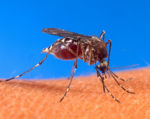Culicidae
Revision as of 14:41, 29 March 2010 by Bara (talk | contribs) (Created page with 'thumb|right|150px|''Aeges aegypti'' - Wikimedia Commons *Also known as mosquitoes *Found worldwide *Attack a wide variety of animals including human…')
- Also known as mosquitoes
- Found worldwide
- Attack a wide variety of animals including humans
- The most important species of veterinary importance are
- Culex
- Aedes
- Anopheles
Recognition
- Small flies 2-10mm long
- Forward pointing proboscis
- Slender body and long legs
- Narrow wings
- Veins and rear margins of wings fringed with scales
Life cycle
- Eggs laid on water
- Either laid singly or in rafts
- Larval and pupal stages are aquatic
- Visible hanging from the water surface
- Life cycle takes 2 weeks to several months to complete
- Temperature dependent
Pathogenesis
- Most active at night
- Painful, irritating bites
- Only females suck blood
- Transmit human diseases
- Viruses such as dengue fever, encephalitis and yellow fever
- Parasites such as malaria caused by Plasmodium and filarial nematodes which cause elephantosis (Wuchereria and Brugia)
- Transmit animal diseases
- Viruses such as arbovirus which causes equine encephalitis and rabbit myxomatosis
- Parasites such as the canine heartworm, Dirofilaria immitis and avian malaria caused by Plasmodium
Control
- Destroy breeding sites by drainage and removal of objects which collect water
- Repeat applications of insecticides
- Synthetic pyrethroids sprayed from helicopters
- Mineral oils applied to breeding sites
- Education
- Future control methods being developed, such as genetic engineering and biological control methods
